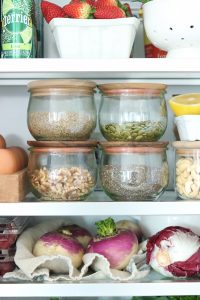Stocking your fridge and pantry to nourish your family is the single-best way to set yourself up for success. Buy the best-quality, real food ingredients you can afford, and you will see, taste and recognize the difference in how you feel. Below I have included some of my favourite fridge essentials that I always keep on hand, so I can at the last minute make a healthy pasta sauce, soup, salad, or frittata. These are items that you’ll see come up time and time again in my recipes.

NUTS, SEEDS, AND BUTTERS
Cashews have a deliciously creamy, fatty texture and mild flavor. They are incredibly versatile and can be used in both savory dishes like stir-fries and also in sweet desserts. They’re an excellent dairy replacement in vegan cheesecakes and creamy sauces. When soaked and blended with water, cashews also make a wonderful non-dairy milk alternative that’s slightly sweet, creamy and, unlike other nut milk, is ready to drink without straining. Cashew butter is something we commonly use in my house to provide flavor and variety to our healthy fat intake. I love adding cashew butter to smoothies, drizzling it over breakfast foods like pancakes and waffles, or just enjoying a spoonful as a quick and nutritious snack. Roasted cashews also make a hearty, filling snack on their own or a great addition to granola.
Almonds are packed with nutrients like vitamin E, B2 (riboflavin) and magnesium, along with fiber, protein, and healthy fats. Almonds can help lower cholesterol and prevent heart disease and heart attacks; their high healthy fat content keeps you feeling fuller longer. They also support proper brain function, maintain glowing skin, control blood sugar levels, fight inflammation and improve digestive health. When soaked, peeled and blended with water, they make a tremendous non-dairy milk alternative. Whole almonds are an excellent snack and can be added to breakfast cereals and granola. I also love to use almond butter on toast with jam or toasted almonds for added crunch on salads.
Peanuts. While commonly mistaken for nuts, peanuts are, in fact, a member of the pea family. They grow in pods under the ground, and for this reason, they can contain high levels of a specific fungi which produces a group of toxins called aflatoxin. To ensure that you’re not ingesting any aflatoxins, I always recommend purchasing organic peanut butter. I like to use the Nuts to You brand of organic peanut butter, as it is tested to ensure that aflatoxin is at a safe level. It’s important to always eat a variety of foods, so try mixing it up with other nut and seed butters for maximum nutrition.
Sesame Seeds are incredibly high in calcium, making them a great food for strong bones and teeth. They are also high in iron and magnesium and help the liver in detoxification. Whole sesame seeds can be sprinkled onto baked goods and salads; while sesame oil is a great option for sauces, salad dressings, and dips, as well as being an excellent high-heat cooking oil for stir-fries. Ground sesame seeds are used to make tahini, a smooth paste commonly added to Middle Eastern dishes.
Tahini, also known as sesame seed paste, is a thick paste made from ground sesame seeds. Tahini is most commonly used in Middle Eastern dishes like hummus and baba ganoush, a dip made from roasted eggplants. Tahini is a great option to add to sauces and dips to give them a luscious, creamy texture, and it also contributes to desserts.
Hemp Seeds have recently exploded in popularity, and not just in health food circles. These small seeds are packed full of healthy fats and can be toasted or eaten raw. They have a mild, nutty flavor that works well when sprinkled on salads, soups, and oatmeal, or blended into smoothies. Hemp seeds help fight inflammation and are a rich source of magnesium, which is key in reducing muscle cramps. They also help combat menopausal and PMS symptoms. Hemp seeds can be used to make hemp milk, hemp protein powder, and hemp oil.
Chia Seeds are tiny black or white seeds. They are full of nutrients including fiber, protein, antioxidants, calcium, magnesium, and omega 3s. They’re great for skin health, digestive health, and heart health. When added to liquid they form a jelly-like substance which can mimic eggs in vegan recipes; it can also be used to make deliciously creamy chia pudding or added to smoothies and other sauces for thickening.
Flaxseeds are small brown, tan, or golden-colored seeds containing lots of nutrients such as fiber, protein, and omega 3s. They are excellent for healthy skin and hair, reducing cholesterol and promoting healthy bowel movements. When mixed with water, they create a gelatinous mass that can be substituted for eggs in baking. They are best absorbed when ground, however, due to their high-fatty acid content, they are prone to rancidity. I recommend grinding them fresh at home in a coffee grinder, or storing ground flaxseeds in the freezer. They should be slightly sweet and nutty. If they taste bitter, they have gone rancid and should not be used.
Pumpkin Seeds, also known as pepitas, can be eaten raw or roasted, and are used in both sweet and savory dishes. They are rich in protein, magnesium, iron, and zinc, helping to boost the immune system as well as promote muscle relaxation and support prostate health in men. They make a fantastic addition to salads, soups, as a stand-alone snack, or in protein balls. They are also high in the amino acid, tryptophan, which promotes restful sleep. Pumpkin seed oil and pumpkin seed butter are even great options to add to your diet.
Sunflower Seeds are one of the most common seeds in North America. They are a delicious and healthy snack and can be added to foods like salads, breakfast cereals and granolas, soups, protein balls, and smoothie bowls. Sunflower seeds are very high in antioxidants, namely vitamin E and selenium, which help reduce inflammation, promote heart health, lower cholesterol levels, support healthy thyroid function and promote skin health. I also like to have sunflower seed butter on hand as it makes a tasty alternative to peanut butter.
Walnuts are arguably one of the healthiest nuts available. These tiny brain-shaped morsels are excellent for brain health. Thanks to their high-healthy fat content, they are also suitable for heart health, reducing inflammation and increasing male fertility. They are a rich source of B vitamins, which help boost mood and energy levels. I love using walnuts to add texture and crunch to salads. Due to their high-omega-3 oil content, they can go rancid quickly, so store them in a cool, dark place, and use as soon as possible. The fridge will prolong their shelf life, as will purchasing walnuts in the shell.

MEAT, EGGS, DAIRY, AND NON-DAIRY ALTERNATIVES
Chicken. When selecting chicken and poultry, I recommend buying the best quality you can afford. An organic label on poultry ensures that the animals have been fed organic feed, and contain no hormones or antibiotics. It does not, however, guarantee the animals’ living conditions. They may be kept in cages, and they may not have enjoyed any access to the outdoors during their lives. The best option for poultry is pasture raised. This label ensures that the animals receive ample opportunity and space to roam around outside, often on organically managed pastures.
Beef. When selecting beef be sure to purchase meat that is both hormone and antibiotic free. For the highest standard and maximum nutrients, purchase grass-fed beef, but be aware that the term “Grass-fed” is not regulated. While it often means exactly what you imagine, that the cattle have happily grazed in a pasture their whole lives, it could also mean other things. For example, it could mean “they ate grass until we started feeding them grain to fatten them up for market.” It could also mean “we raised them on grain but let them graze for a few weeks so we could say they were grass-fed.” A cow that has been sustained on mother’s milk, fresh grass, and grass-type hay contains the highest levels of antioxidants, beta-carotene, and vitamin D; as well as 2–-3 times healthier omega-3s as conventional grain fed beef. My advice: Get to know your butcher! Ask questions. Your butcher will know all about the beef that will be bought for your local market.
Salmon. When selecting salmon, halibut and other fish, I recommend always opting for a wild, sustainably caught product. Commercial fishing ventures worldwide net up to 40% by-catch, including dolphins, sea turtles, whales, seabirds, and other marine life. Often these animals are injured or even killed in the process. By selecting sustainably caught, hook-and-line seafood, we can significantly reduce the number of animals unnecessary harmed in the fishing process. Also, wild-caught fish contain higher levels of omega 3s and vitamin D, compared to factory-farmed fish that are fed a diet of GMO corn and soy pellets.
Stock and Broth – Vegetable, Chicken, Beef. Many people assume that stock and broth are interchangeable terms, yet technically speaking, there are some key differences. Stock is typically made with animal bones and some scraps of meat, some aromatics and onions, celery and carrots. It is generally cooked for 2–6 hours and may be slightly gelatinous when cooled. The stock is also left unseasoned.
Conversely, the broth is traditionally made by simmering meat, sometimes with bones but not always, some aromatics, onions, carrots, and celery. It is always seasoned and cooked for under two hours. This yields a thin, flavorful liquid. With the recent rise in popularity of bone broth, this traditional culinary description has changed. We now consider broth to include cooking mainly bones for a long time, sometimes longer than 24 hours, resulting in a rich and nutritious gel-like soup that can be used as a base for sauces, gravies, or enjoyed on its own. Bone broth is an excellent source of minerals and nutrients, helping to heal the digestive tract, promote youthful skin and healthy hair and nails. Vegetable, chicken and beef stock, and broth can easily be made at home with vegetable or meat trimmings, or found at many gourmet grocery stores, often in the freezer section.
Eggs. When selecting eggs, some labels mean more than others, so be sure to purchase the best-quality eggs you can afford. At the top of the list are eggs from pasture-raised hens where the chickens can roam freely, eating what they find in their natural surroundings. While cage-free eggs are a step-up from commercial ones, this designation does not guarantee that the chickens have enjoyed any time outdoors, and were fed a natural, nourishing diet. I recommend purchasing eggs from a local farm at your farmers’ market to get a natural, good-quality product that is full of key nutrients such as healthy fats and vitamin D.
Dairy. Cheese, yogurt, and milk are foods that many people commonly purchase commercially, without considering the benefits of organic or grass fed. Also, we’ve been convinced over the years that low-fat dairy is the healthy option. Neither of these could be further from the truth. Just like meat products, purchasing the best-quality dairy you can afford is of utmost importance. Whole milk from organic, grass-fed cows contains 147% more omega 3s than commercially farmed milk. For the healthiest choice, always opt for full-fat dairy products. Low-fat dairy, as in low-fat yogurt, is often packed with sugar and artificial thickeners to make up for the lack of fatty flavor and texture. We now know that fat is good for us, and eating small amounts of healthy full-fat dairy is a better choice than low-fat dairy options.
Non-Dairy Options. For those who are lactose intolerant or may experience allergy-like symptoms when eating dairy, we are fortunate to have a wide variety of non-dairy alternatives at most grocery stores. These include non-dairy milk such as almond, cashew, coconut, and hemp, as well as coconut yogurt. New products like tigernut and pea milk are hitting the market every day. Always read the ingredient labels to ensure that these products are not packed with preservatives and thickeners like carrageenan and sweeteners.

FRUITS AND VEGETABLES
Being a nutritionist, lots of people ask me for the secret to being healthy. If I had to pick just one thing, it would be variety. I am a huge advocate of eating a varied diet. No matter how healthy food is, if we eat the same things over and over again, we will not be able to get the maximum amount of nutrients our bodies need to thrive.
One of Mother Nature’s greatest miracles is the many assorted varieties of fruits and vegetables available each season. By selecting seasonal produce, we will not only eat the way nature intended, we will also receive the vital nutrients we need for that given time of the year. Selecting seasonal produce also means you’ll save money, support local farmers and enjoy the benefits of the tastiest, most nutritious food available. And it will give you that variety in your diet I’m talking about.
Of course, depending on where in the world you live, you may not be able to get fresh, local produce year round. In many parts of North America, it is just too cold to grow anything during the snowy winter months, so it is all the more important to take advantage of seasonal produce when it is available. We can also continue to benefit from seasonal produce by preserving food through jarring, pickling, or freezing. I love to make my fresh tomato sauce at the end of the summer and freeze fresh berries and peaches when they are in season, so I can benefit from summer’s bounty during the cold winter months.
Below are a few of my favorite fruits and vegetables, the ones I try always to have on hand. While I may not purchase them every time I go to the store, I try to cycle through these staples, working with what’s available seasonally, to maximize my family’s intake of nutrients and enjoy the delicious flavors. I also like to mix in one or two new fruits or vegetables each week so that… even our variety is varied!
Fruits
- Berries
- Tomatoes
- Oranges
- Lemons
- Limes
- Apples
- Grapefruit
- Bananas
- Avocados.
Vegetables
- Spinach
- Kale
- Cabbage
- Broccoli
- Cauliflower
- Carrots
- Leeks
- Asparagus
- Romaine
- Baby potatoes
- Sweet potatoes
- Onions
- Garlic
- Ginger
- Beets
Let’s not forget herbs! Many people fail to realize that herbs are not just for adding fantastic flavor to meals, they are also packed full of nutrients. Think herb tea? I like to cultivate a little herb garden at home so I can quickly and easily snip fresh herbs for my recipes. Some of my favorites include parsley, cilantro, mint, thyme, sage, rosemary, basil, and dill.
Now, who’s motivated to clean out the fridge, re-stock and get cooking!
xo
Karlene
Learn more health and wellness tips from Karlene Karst.
